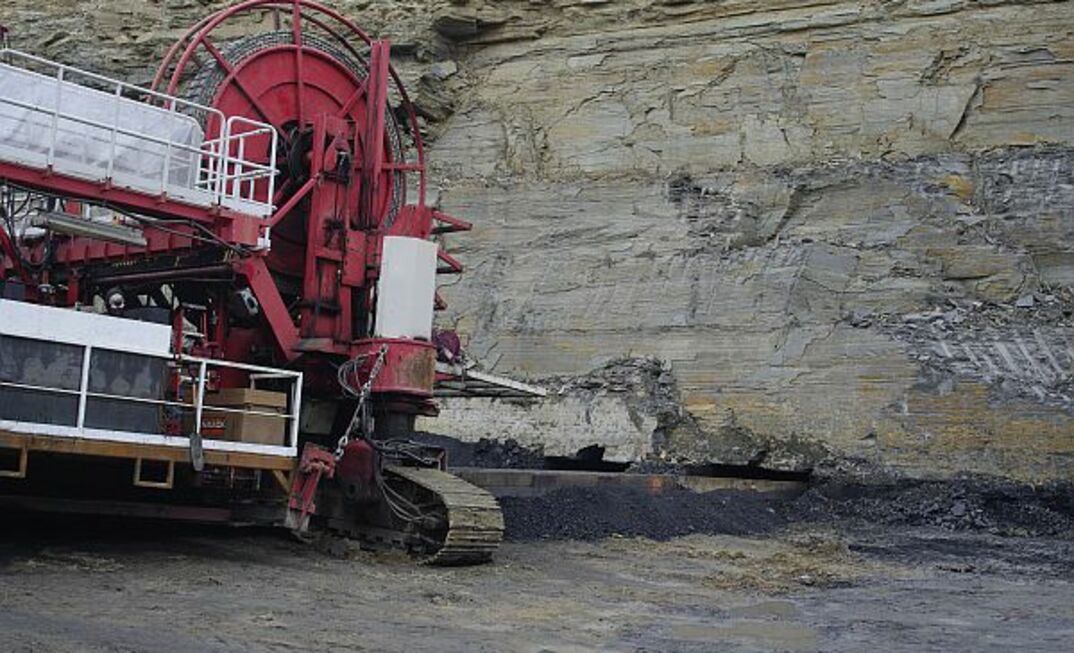It is a technique called highwall mining, a relatively recent development in the surface mining sphere and one that brings underground mining techniques to bear.
In the version Supply Side saw in action at a coal mine in Ohio, a continuous miner head was mounted on push beams.
Those 6m long push beams, which each had two augers inside them, were gradually linked together and pushed into the coal seam.
The cut coal was drawn out by the augers onto a conveyor system that took the coal off to the side where it could be loaded for removal.
In some cases the coal being cut is so clean it can be direct-shipped. The push beams help here because they convey the mined coal inside, protecting it from contamination.
The highwall approach could arguably be called a room and pillar on the surface approach because it cuts sections of coal leaving behind pillars to hold up the highwall. Indeed, the highwall mining division sits inside Caterpillar’s room and pillar group.
However, unlike other room and pillar products, there is no need for anybody to go underground or to even get too close to the highwall.
The Caterpillar HW300 highwall mining system can operate with just four crew.
To make highwall mining work, there needs to be a very good understanding of the coal seam.
In the control room the operator has a couple of gauges to let him know how close they are to the rock – the amount of amps the cutting motors are drawing as well as a gamma sensor.
In very simple terms, as the gamma ray count rises, the coal is getting thinner and the rock ever closer.
Given it is a $1 million cutter on the end of those push beams, getting out of the coal seam and causing the head to be trapped would be a rather expensive mistake.
The gamma sensor side of things only really works when the rocks around the coal actually emit gamma rays.
There also is a fibre optic sensor that calculates how far the cutter head has moved.
The cutter head has a couple of “rudders” that can steer it back on track if necessary. These rudders simply push against the rib to steer the machine back on track.
JD Fairchild – a member of the Fairchild family that recently Fairchild International to GE in 2012 – is commercial manager for the Caterpillar HW300 highwall miner division.
He said the company had plans to bring its highwall miners to the Australian market.
Not that Australia has been ignoring the technology. Some central Queensland coal mines have mined their highwalls and the Griffin coal mine near Collie in Western Australia also had an earlier version of the machines Caterpillar produces.
That Collie highwall miner ended up being sold to an Indonesian operation when Griffin hit financial difficulties. That machine had been performing well in its Indonesian mine until a higher than normal rain event led to a swamp overflowing and the machine being submerged.
The actual story of how Caterpillar came to be in the highwall mining game is kind of interesting. A Dutch company started off making them with plans to ship 40 of the machines to the US. It fell on hard times and went broke having shipped only 16.
Superior Highwall Miners came along in 1994 and took over that technology before being snapped up by Terex, which was bought by Bucyrus that was ultimately consumed by Caterpillar.
Caterpillar Global Mining highwall miners product line manager Stewart Myers said that with a highwall miner, up to 70% of the coal that could be reached could be recovered.
With the Caterpillar offerings, 300m is an accepted reach for the highwall miners, although Myers believes 400m is in the realms of possibility.
Another highwall miner maker, Addcar, claims that its highwall miner can cut 500m into the highwall.
How far the miner can cut into the highwall is determined by the amount of pulling power it has.
This is because it requires more power to pull the cutter head and the push beams out than it does to push them in – and, remember, that cutting head costs $1 million to replace.
It also highlights the importance of the pins that clip the push beams together. It is these pins that have to withstand those greater pulling forces when it comes to retrieving the highwall assembly from the coal seam.
That said, going beyond the 400m or 500m mark is quite in the realms of possibility.
As Fairchild points out, highwall miners have only really been around since the 1960s and are constantly evolving.
The one operating in the Ohio coal mine was quite an old one and the newer ones Caterpillar offers can cut almost twice the coal these days.
Caterpillar’s highwall miner offering can cut coal seams up to 4.5m thick and also down to about 70cm thick.
There is a regulatory benefit to the technology too.
“Regulators like them because they do the reclamation to the latest standards,” Fairchild said.
Myers said there had been a lot of interest in the highwall mining system since it had become part of the Caterpillar dealer network offering.
“We’re seeing interest from Africa, Australia and Indonesia,” he said.
“We have four machines in Russia. We have one in India and should be shipping another machine there next year.”
Myers said in the US the bulk of the highwall miner users were in Appalachia although there is one in Alabama, one in Utah and at least one operating in Ohio.
Fairchild admitted that highwall mining was a niche mining application but one that was very effective if the conditions were right.
























